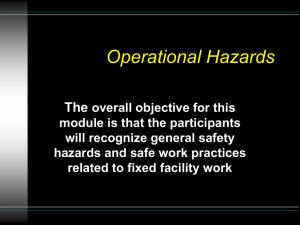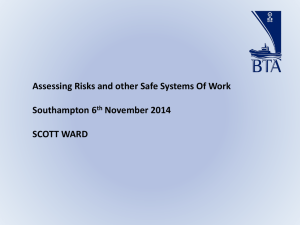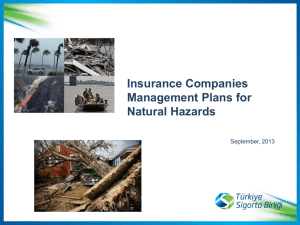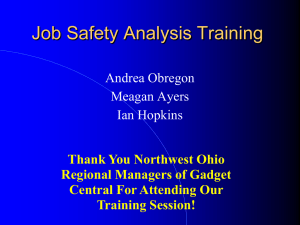Risk Assessment
advertisement
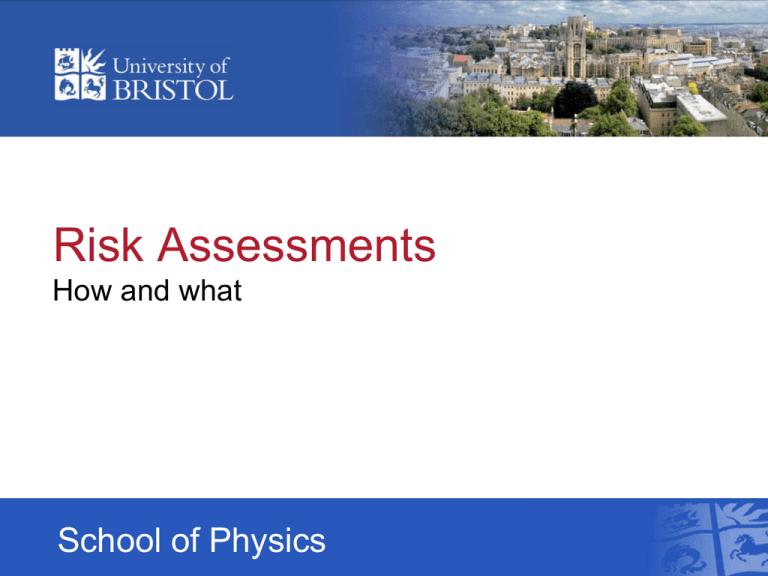
Risk Assessments How and what School of Physics Risk Assessments • You have carefully thought out all the angles • You have done it a hundred times • It comes naturally to you • You know what you are doing, it is what you have been trained to do all your life • So nothing could possibly go wrong • Could it ?? Think Again! No beavers were actually injured during the creation of this PowerPoint presentation! Risk Assessment “A systematic evaluation of the work place and/or other activities which identifies the hazards present and gives an estimate of the extent of the risks involved” Risk Assessment – The History •Always been here •Concept introduced with the Health and Safety at Work Act 1974 •Concept expanded upon in the Management of Health and Safety Regulations 1992 (1999) •Integral to all other appropriate legislation i.e. CoSHH, PPE, Noise etc So what is the concept of Risk Assessment? Hazard Anything that may cause harm Risk The probability of harm occurring Chance of exposure to the hazard X Consequences (severity) Task or Area Based ? Area Based • Normally used for identifying common hazards in the workplace • Will also be used to identify TASKS to be individually risk assessed Area Based Example A risk assessment of administrative areas will lead to the identification of the following hazards: Slip, trips and falls Electrical Safety Computer workstation hazards Manual Handling Area Based Example • The common hazard of slips trips and falls can be dealt with through the School policy. • The electrical safety will also be School policy with regard to inspection and PATesting. • Manual handling and the computer work stations will have to be risk assessed on a task basis. Task Based • A specific task or job will be risk assessed • All the hazards associated with the task will be assessed electrical biological chemical radiation manual handling falls from height, etc 5 Steps To Risk Assessment Step One Identify the hazards Methods Of Identifying Hazards • • • • • • • Health & safety audits Academic journals Research papers Consultation with other co-workers Accident reports Trade organisations HSE statistics Methods Of Identifying Hazards • Similar Institutions • Outside Advice (manufacturers of equipment and materials) • Internal Advice (University Safety & Health Services) Step Two Identify who might be harmed Who Might Be At Risk •Employees •Contractors •Visitors •General public •Children •People who share the workplace •Must be people specific Don’t forget vulnerable groups such as people with disabilities, pregnant staff and those with little experience or training. Step Three Evaluate the risks Risk Analysis • Hazards and hazardous situations are systematically identified. • The level of risk associated with each hazard (situation) is estimated Risk Evaluation • A judgement is made as to whether the level of risk is acceptable or tolerable • Will include a judgement on corrective or preventative measures Completing the Risk assessment Organising actions and responsibilities to reduce the hazards and risks to acceptable levels: Elimination of hazard (do I have to do this?) Substitution (materials, equipment etc) Physical safeguards (machinery guarding, extraction etc) Personal Protective Equipment Safe working procedures Or any combination of above Completing the Risk assessment Writing safe working procedures or instructions General procedures may be in local rules Specific procedures must be included in the risk assessment Evaluating The Risks -some considerations • • • • • • • • • Industry standards Legal requirements Precautions already taken Cost (so far as is reasonably practical) Different working conditions i.e. weather Numbers of people at risk Severity of injury Probability Length of exposure/frequency Step Four Record your findings Recording the Risk Assessment The Elements A description of the area or task The hazards that personnel may be exposed to Details of the personnel who may be exposed to the hazards Recording the Risk Assessment Details of which hazards are significant and those which are acceptable (and why) The precautions in place, or to be put in place, to reduce the significant hazards to acceptable levels How the precautions are to be maintained (management of systems, inspection of physical precautions etc) Recording the Risk Assessment • Details of additional risk assessments i.e. hazardous substances (COSHH) • Emergency Procedures • Details of person completing the risk assessment • Details of person countersigning the risk assessment • Date, school or group, location details etc. Recording the Risk Assessment Evaluate the risks • • • • • • Use the risk matrix on the form Estimate the risk before control measures Identify control measures to lower the risk Estimate the risk after control measures (residual risk) Can you lower the risk further? Ideally all LOW Not all risks are injury – what about financial loss? Recording the Risk Assessment Consequence L i k e l i h o o d Minor injury or no apparent injury Injury requiring first aid Injury requiring medical treatment, or with possible long term negative health effects Will probably not occur in most circumstances Low Low Medium May occur in some circumstances Low Medium High Likely to occur in most circumstances Medium High High Recording the Risk Assessment Signatures • • • all Low Risk - Principal Investigator (YOU). If not competent to do so, then also a Competent Person any Medium Risk - Principal Investigator and Competent Person (not the same) any High Risk – PI and CP, then referred to Head of School and Safety Manager for formal authorisation School of Physics Policy • Use standard School risk assessment form or Specific RA form for hazards like lasers • Must be readily available in the laboratory on paper • Must be appropriately signed • Review at least annually or on changes • Copy provided to Head of Group and School Safety Manager • Work not covered by a suitable and sufficient risk assessment can be stopped by SSA, HoS, SSM, University Safety & Health Services or HSE. School of Physics COSHH / Risk Assessment Title: Ref: Name of Principal Investigator Description of Task / Activity (including frequency / duration) Location Names/Type of Persons Involved / At Risk Should the personal circumstances (such as pregnancy or any other medical condition) of any person involved change, this risk assessment MUST be reviewed. Hazards Activities, substances, machines, tools, etc. Hazards identified Estimated risk (low/medium/high) 1. 2. 3. 4. 5. Precautions required to mitigate risk (relate to numbers above): Estimated risk after precautions (low/medium/high) 1. 2. 3. 4. 5. Emergency Procedures and Contacts Lone / Out-of-Hours Working Training Requirements Access Restrictions / Signage Storage Waste Disposal Principal Investigator Competent Person (in all cases) Signature Date (medium / high risk) Signature Date Date for Next Assessment (must be reviewed within 12 months) Step Five Review the assessment Legal Summary The Management of Health and Safety at Work Regulations 1999 (amended 2006) Risk assessment 3.—(1) Every employer shall make a suitable and sufficient assessment of— • • (a) the risks to the health and safety of his employees to which they are exposed whilst they are at work; and (b) the risks to the health and safety of persons not in his employment arising out of or in connection with the conduct by him of his undertaking, for the purpose of identifying the measures he needs to take to comply with the requirements and prohibitions imposed upon him by or under the relevant statutory provisions and by Part II of the Fire Precautions (Workplace) Regulations 1997. Risk Assessment Strategy 1. Identify the hazards 2. Evaluate the risks 3. Detail the control measures required to eliminate or reduce to risks to acceptable levels Summary Recording the significant findings of the risk assessment. What the task is Who is responsible/supervisor Where the risk assessment applies, who is affected List of hazards List of precautions Details of safe working procedures Emergency procedures Reference to other associated risk assessments i.e. COSHH, manual handling, PPE etc. Summary Organising actions and responsibilities to reduce the hazards and risks to acceptable levels: Elimination of hazard Reduce by substitution (materials, equipment etc) Physical safeguards (machinery guarding, extraction etc) Personal Protective Equipment Safe working procedures Combination of above How it can go wrong – a Case Study The Health and Safety Executive have inspected part of the University following a case of occupational asthma and issued the University with an “Improvement Notice” to improve RISK ASSESSMENTS!!! Circumstances of the Improvement Notice • Project studying poultry in various locations (approx 12 years) • Member of staff involved in project never used respiratory protection or considered exposure to animal allergens • Member of staff developed asthma which was later diagnosed as “occupational asthma” i.e. directly connected to the work environment Circumstances of the Improvement Notice • Details reported to the HSE (legal requirement) • HSE investigated and concluded that the risk assessment for the work undertaken was not “suitable and sufficient” (Reg 3 of The Management of Health and Safety at Work Regulations 1999) and served improvement notices under the HASAW 1974 and COSHH Regs 1999 Circumstances of the Improvement Notice • The risk assessment for the activity did not consider the possibility of occupational asthma due to exposure to animal allergens, a condition that was foreseeable • No respiratory protection was considered or provided and no lung function tests were ever carried out (although available) Circumstances of the Improvement Notice • The HSE concluded that although the person involved was working on an individual project, the management of the University should have ensured that appropriate precautions were taken. They also concluded that there was no effective risk management system and that similar hazards may not have been addressed. Other Possible Outcomes The HSE considered a prosecution, which would have probably been successful. In the circumstances they felt that the willingness of the University to improve its systems meant that an “Improvement Notice” would serve the interest of health and safety better. Examples • Insured losses Compensation claims (UV burns £116k) (Back Injury £33k) Loss of business etc?? • Uninsured losses Fines of up to £20k, but last time………. » Fines (£3k) » Costs (£7k prosecution, £10k defence) (£20k) from School resources ! The “cost” of Discharging the Notice The following is a breakdown of the hours spent discharging the Notice: School Safety Advisor – 460 Hours Divisional / Area Safety Advisors (6) – 1700 Hours School Staff - 2800 Hours Total: 4960 Hours or 124 working weeks Case Study • Ordered Conc. Sulphuric acid from a dubious but cheap supplier • Arrives on a wooden & damaged pallet, glass winchesters loosely secured by shrink film. • Left on loading bay and needs moving to the stores for safety. • Pallet appears to be damp in places.




